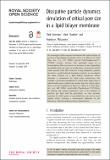Files in this item
Dissipative particle dynamics simulation of critical pore size in a lipid bilayer membrane
Item metadata
| dc.contributor.author | Bowman, Clark | |
| dc.contributor.author | Chaplain, Mark | |
| dc.contributor.author | Matzavinos, Anastasios | |
| dc.date.accessioned | 2019-03-21T16:30:06Z | |
| dc.date.available | 2019-03-21T16:30:06Z | |
| dc.date.issued | 2019-03-06 | |
| dc.identifier | 257445268 | |
| dc.identifier | fb8b1aba-5ce7-447d-a8a5-a8423c363f46 | |
| dc.identifier | 85064334158 | |
| dc.identifier | 000465470300039 | |
| dc.identifier.citation | Bowman , C , Chaplain , M & Matzavinos , A 2019 , ' Dissipative particle dynamics simulation of critical pore size in a lipid bilayer membrane ' , Royal Society Open Science , vol. 6 , no. 3 . https://doi.org/10.1098/rsos.181657 | en |
| dc.identifier.issn | 2054-5703 | |
| dc.identifier.other | ORCID: /0000-0001-5727-2160/work/55643825 | |
| dc.identifier.uri | https://hdl.handle.net/10023/17338 | |
| dc.description | C.B. was partially supported by the NSF through grant no. DMS-1148284. M.C. gratefully acknowledges support of EPSRC grant no. EP/N014642/1 (EPSRC Centre for Multiscale Soft Tissue Mechanics–With Application to Heart & Cancer). A.M. was partially supported by the NSF through grant nos. DMS-1521266 and DMS-1552903. | en |
| dc.description.abstract | We investigate with computer simulations the critical radius of pores in a lipid bilayer membrane. Ilton et al. (Ilton et al. 2016 Phys. Rev. Lett.117, 257801 (doi:10.1103/PhysRevLett.117.257801)) recently showed that nucleated pores in a homopolymer film can increase or decrease in size, depending on whether they are larger or smaller than a critical size which scales linearly with film thickness. Using dissipative particle dynamics, a particle-based simulation method, we investigate the same scenario for a lipid bilayer membrane whose structure is determined by lipid–water interactions. We simulate a perforated membrane in which holes larger than a critical radius grow, while holes smaller than the critical radius close, as in the experiment of Ilton et al. (Ilton et al. 2016 Phys. Rev. Lett.117, 257801 (doi:10.1103/PhysRevLett.117.257801)). By altering key system parameters such as the number of particles per lipid and the periodicity, we also describe scenarios in which pores of any initial size can seal or even remain stable, showing a fundamental difference in the behaviour of lipid membranes from polymer films. | |
| dc.format.extent | 9 | |
| dc.format.extent | 1490349 | |
| dc.language.iso | eng | |
| dc.relation.ispartof | Royal Society Open Science | en |
| dc.subject | Dissipative particle dynamics | en |
| dc.subject | Lipid membranes | en |
| dc.subject | Computational simulation | en |
| dc.subject | QA75 Electronic computers. Computer science | en |
| dc.subject | QH301 Biology | en |
| dc.subject | RC0254 Neoplasms. Tumors. Oncology (including Cancer) | en |
| dc.subject | T Technology | en |
| dc.subject | DAS | en |
| dc.subject | SDG 3 - Good Health and Well-being | en |
| dc.subject.lcc | QA75 | en |
| dc.subject.lcc | QH301 | en |
| dc.subject.lcc | RC0254 | en |
| dc.subject.lcc | T | en |
| dc.title | Dissipative particle dynamics simulation of critical pore size in a lipid bilayer membrane | en |
| dc.type | Journal article | en |
| dc.contributor.sponsor | EPSRC | en |
| dc.contributor.institution | University of St Andrews. School of Mathematics and Statistics | en |
| dc.contributor.institution | University of St Andrews. Applied Mathematics | en |
| dc.identifier.doi | https://doi.org/10.1098/rsos.181657 | |
| dc.description.status | Peer reviewed | en |
| dc.identifier.grantnumber | EP/N014642/1 | en |
This item appears in the following Collection(s)
Items in the St Andrews Research Repository are protected by copyright, with all rights reserved, unless otherwise indicated.

